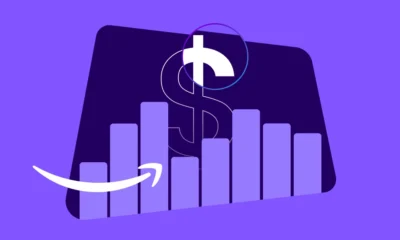PPC
How the TikTok Algorithm Works in 2024 (+9 Ways to Go Viral)

If you post videos and want more people to spend more time watching them, then you and TikTok have a common goal. That’s why I cringe a bit when I see people talking about hacking the TikTok algorithm for more likes and views.
You don’t need to trick it; you just need to know how the TikTok algorithm works. Once you understand its basic principles, you’ll know what and when to post for your best shot at TikTok virality.
But what about the potential US TikTok ban? TikTok has 148 million active users in the US. To paraphrase Samual L. Jackson’s character Nick Fury in Marvel’s Avengers, “Until such time as the world TikTok ends, we will act as though it intends to spin on.”
Let’s get into the weeds of TikTok’s algorithm, see how it suggests videos to individual users, and find ways to get your content on more viewers’ screens.
Contents
What is the TikTok algorithm?
The TikTok algorithm is a recommendation engine that decides which videos to suggest to each individual user.
On TikTok, recommended videos appear on your For You Page (FYP) when you first open the app.
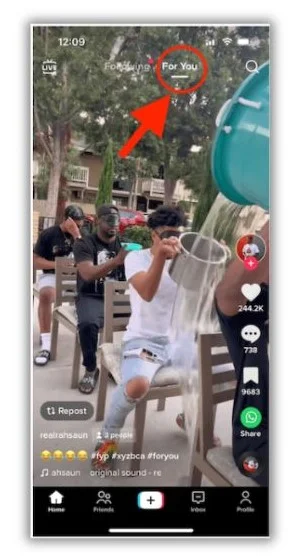
Everyone’s For You feed is unique and will change over time. TikTok pays attention to the videos you watch, where you post comments, and the accounts you follow. Each interaction is another signal the algorithm uses to refine your FYP—showing videos you’ll probably like while keeping videos you won’t off your feed.
💡 Want to grow all of your marketing channels? Download The Best Online Marketing Tips for Generating More Traffic, Leads, & Sales to get over 100 actionable growth marketing tactics.
How does the TikTok Algorithm work in 2024?
If you’ve ever sent your friend a cake recipe link because you remembered they love to bake, you get the gist of how the TikTok algorithm works.
Of course, TikTok’s proprietary algorithm is infinitely more complex than yours (no insult intended). It analyzes thousands of signals to determine which videos belong on your FYP. Let’s look at a few of the most influential ranking factors.
Factors TikTok uses to rank content
We’ll probably never know what every TikTok ranking factor is, but thanks to this post from TikTok itself, we do have an idea of a few ranking categories.
User interactions
Your behavior in the TikTok app is the most influential signal for the algorithm. Whenever you like a video or follow a particular account, TikTok uses that to understand your preferences further.
These are some of the user interaction signals TikTok will track:
- Watching full videos
- Following or hiding accounts
- Liking or sharing videos
- Commenting
- Reporting a video as inappropriate
- Adding videos to favorites
TikTok also uses what you say you are and aren’t interested in when you first join the app to guide its suggestions.
Other users’ interactions on a video can also determine whether you get it on your feed. If many people who share your interests watch and like a post, there’s a bigger chance you’ll see it, too.
Video information
On the flip side of the equation, TikTok reviews certain characteristics of the videos you’ve interacted with to see how they match your preferences. That’s important for creators to know since these are the things we have the most control over.
Here are a few of the video and post characteristics the algorithm looks for:
I’ll go into how to optimize your videos for TikTok marketing using these characteristics in a bit.
Device and settings
Device and settings are also user-specific actions the algorithm uses to recommend content. If you’re registered as a US user, you’ll see a lot more content made in the USA. But unlike user interactions, these are one-time signals that don’t typically change over time.
A few device and setting signals that may nudge the TikTok algorithm include:
- Language setting
- Country setting
- Device type
TikTok factor weighting
TikTok’s algorithm weights ranking factors based on how directly they indicate viewer preferences. Direct user actions, like watching a full video, carry much more influence than geographic location.
This means that while it’s good to be aware of all the ranking factors, your focus should be on posting content that your audience will want to watch and share.
Factors that don’t help (and could hurt) your content ranking
In its post, TikTok says it won’t give creators a boost based on past performance. Someone with a high follower count and previously viral videos won’t get preferential rankings over a smaller account with more relevant content.
Additionally, there are some types of content that TikTok will de-rank (show less or not at all) in your FYP. These include:
- Videos you’ve already seen
- Content that’s considered spam
- Duplicated content (like a second post of the same video)
- Videos with restricted content (like graphic medical procedures)
To be clear, some of this content will still be available if you search for it. It just won’t pop on your FYP.
How to reset the TikTok algorithm
TikTok’s algorithm finds the type of content you’ll love based mainly on what you’ve enjoyed in the past. Sometimes, the recommendations don’t keep up with your changing preferences, and your feed gets stale.
TikTok has built a way for you to scrub its algorithm so it starts from scratch. Then, your interactions moving forward will influence the content you get on your personal FYP.
Here are the steps to refresh your FYP:
- Open the TikTok app and tap “Profile”
- Go to the menu at the top and choose “Settings and privacy”
- Tap “Content preferences”
- Tap “Refresh your For You feed”
- Tap “Continue” and “Continue” again
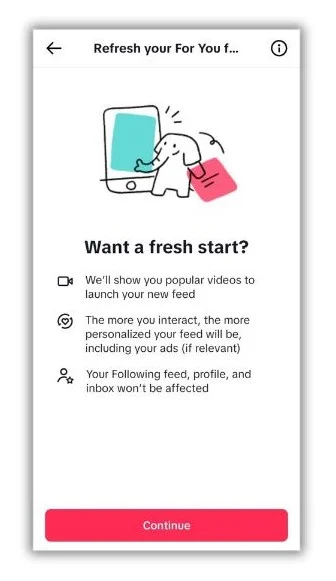

You can’t go back once you finish the process. But only your FYP will be affected. Your “Following” feed and profile won’t change.
📣 Free guide >>> 135 of the Best Words & Phrases for Marketing With Emotion
9 ways to use the TikTok algorithm to your advantage
Knowing how the TikTok algorithm works is half the battle. The other half is publishing engaging content that makes it easy for TikTok to find, categorize, and suggest your posts.
1. Hook viewers quickly
You have a fleeting second or two to grab a viewer’s attention and convince them to watch your video. Keep their thumbs from scrolling by adding an attention-grabbing hook that’s relevant to your audience.
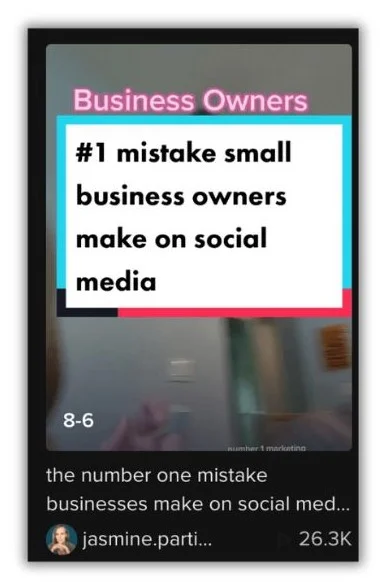

A great hook should give the viewer just enough information to make them want more. Try these tactics for your video hooks:
- Make a bold claim
- Ask a question
- Share a surprising fact
- Hint at a secret
Make sure each hook is relevant to your audience, and use emotional words to catch their attention.
2. Create niche content
It’s hard to gain footing with very popular topics on TikTok since many creators are already fighting for precious FYP placement. However, you can use the algorithm to your benefit by finding niche topics to post about.
For example, cooking is a super popular topic on TikTok. There are plenty of accounts dedicated to whipping up the best dishes. But Bobby Hicks of @theretrorecipekitchen uses his account to trial dishes from days of old. Many of the recipes he tests look tasty, while others look like…a veggie gelatin stack?


It may seem a little odd, but by focusing on one corner of a popular topic, Hicks has grown his account to over 150k followers.
Review the topics you’d like to use, and if they seem a little crowded, find a subtopic your audience would appreciate. That’ll leave you with fewer competitors in the race for the FYP. It’ll also make your content more relevant to a specific audience, which the algorithm loves.
3. Use TikTok SEO
Search engine optimization isn’t just for Google. Pretty much any time there’s a search function, you can optimize your content for it, and TikTok is no exception. Plus, even Google admits that TikTok is becoming a popular search engine in its own right.
In addition to the other tips in this guide, you’ll want to use keyword research to boost your TikTok SEO. Like on search engines, people use specific words and phrases in the search bar to find content on the app. Your job is to figure out what those words are.
Keyword research is easy on TikTok. Make a list of things your audience might search for that are relevant to your business. If you’re an esthetician, “skin care” might be one of them. Then, enter those words into the TikTok search bar and see what it auto-fills.
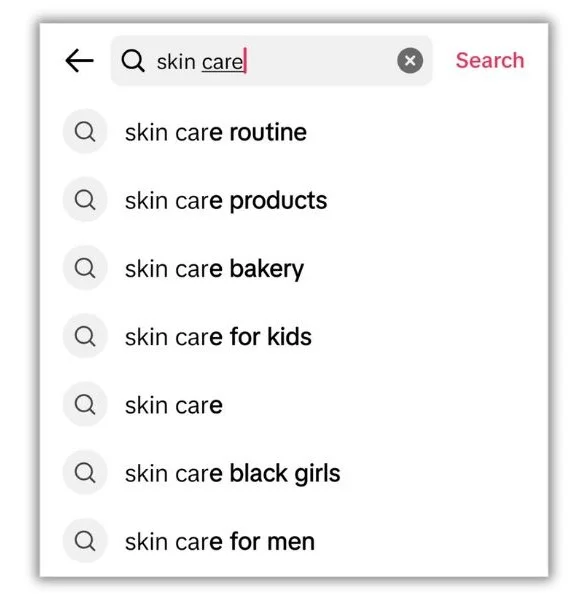

You’ll see options like “skin care for men” and “skin care routine.” Once you’ve gathered a list of keywords, plan out your content calendar to cover each term. Don’t forget to add keywords to your TikTok bio, too.
4. Tailor content to the platform
It’s smart to repurpose content for multiple platforms. But when it’s time to post it on TikTok, make sure it fits the app’s best practices.
First, produce and edit full-screen, vertical videos with a 9:16 ratio. That will fill the entire mobile screen while matching how most people view TikTok content.
Second, keep most of your videos short. While there’s no ideal duration for every video, in 2021, TikTok suggested that the optimal length should be 24 to 31 seconds. The platform has pushed for longer content, but many viewers find videos longer than one minute to be stressful, so it’s safer to keep them under 60 seconds.
Finally, for the best chance of your TikTok videos going viral, keep them positive in tone. Semrush evaluated a large collection of viral TikTok videos and found that those with a positive, funny, or happy vibe did best.
Follow these best practices to get more early engagement, which the algorithm will use as a signal that your video belongs on more FYPs.
5. Post at the right time and frequency
The TikTok algorithm doesn’t really care what time or how often you post—at least not directly. But it does look at how much engagement an individual video gets. Knowing when and how frequently to post can give your videos a little engagement boost.
The right time
The best time to post on TikTok depends on when most of your audience will be on the app. The goal is to publish content a little before the peak potential viewing time to get them indexed and ready for your followers.
You can find that information in your TikTok analytics.


The right frequency
Consistency is essential for success on any social media platform. You don’t want followers to forget about you, and you want more chances to reach new viewers. But how do you quantify “consistency?”
Just like timing, learning how often you should post on TikTok will take some trial and error. TikTok says you should post up to four times per day (of course they do). More realistically, most brands post content to TikTok around two to four times per week (depending on which study you follow).
Here are a few tips to find your perfect TikTok schedule:
- Consider your creative capacity: Posting more often is great, but not at the expense of quality.
- Review other creators: Spy on your competition to see how often successful accounts in your niche post content.
- Watch your analytics: Vary your posting frequency over several weeks and see how it affects your views and engagement.
6. Incorporate hashtags
Using hashtags on TikTok can help you succeed in two ways. First, hashtags help the TikTok algorithm understand your content so it can better match it to user preferences.
Second, TikTok users use hashtags to search for content, so when your video is tagged, it may show up in their search. As we know, when more people see your content, the algorithm will show it to more people with similar interests.
You can find which hashtags are trending in TikTok’s Creative Center.


Here are a few tips for using hashtags on TikTok:
- Don’t use too many: One to four hashtags will usually do the trick without making your post look spammy.
- Use different types: Combine branded, topical, popular, and niche hashtags for the best mix of reach and relevance.
- Include seasonal and holiday hashtags: Adding seasonal hashtags like #hellospring and #Holloweenscares lets you ride the wave of attention during peak times of the year.
7. Add popular audio clips
Audio clips work similarly to hashtags on TikTok. If an audio clip gets popular, and you like videos that use that clip, there’s a greater chance you’ll get more videos with that audio in your FYP.
Head back to the Creative Center to find trending songs.
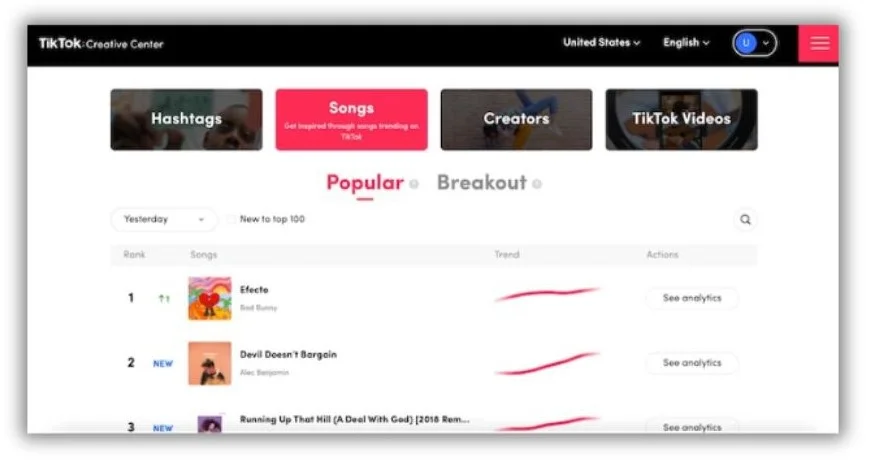

Look in the Popular tab to see which tunes are already getting a lot of play. Then, check out the Breakout tab to catch the next audio wave early.
8. Add captions
Many people don’t watch videos with the sound on. Adding captions to your posts lets those people follow along. But captions don’t just help you appeal to a broader audience. TikTok’s algorithm can learn more about your videos from the text of its caption.
TikTok makes it easy to add captions. Tap the Captions icon, and the app will automatically generate them.


Make sure you use the keywords you dug up in your video script. The algorithm will read those in the captions and know who should see your videos.
9. Jump on trends
One of the best ways to leverage the algorithm to get views is by following TikTok trends. A trend is a theme, idea, or trait of a video that already has mass appeal. That might be a common song or a dance.
Trends can also be challenges, like this one where one person holds another so they look like they’re in the iconic scene from the movie Titanic.


When viewers get hooked on a trend, TikTok sends them more videos to view. If you’ve jumped on the trend, the algorithm will put your video in that mix.
Work with the TikTok algorithm to go viral
The trick to social media marketing is remembering that social platforms want you to succeed. If people love the content you post, they’ll spend more time on the app—which is a win-win for everyone.
The key is learning how the TikTok algorithm works to make it your partner in success. Instead of fighting against the algorithm, find ways to leverage it, and you’ll leap-frog ahead of all the accounts trying to trick or hack it.
Here’s a recap of nine ways you can use TikTok’s algorithm to your advantage:
- Hook viewers quickly
- Create niche content
- Use TikTok SEO
- Tailor content to the platform
- Post at the right time and frequency
- Incorporate hashtags
- Add popular audio clips
- Add captions
- Jump on trends
PPC
Five Product Feed Fixes To Optimise Your Google Shopping Campaign

In the modern landscape of e-commerce, ensuring your products stand out against others is crucial. Millions of shoppers turn to Google Shopping on a daily basis. The ever-increasing competition within the market means the importance of a well optimised product feed is more important than ever. Despite that it’s an area that campaign managers often overlook.
There are many techniques that can be used to optimise your product feed to elevate your listings and maximise performance in Google Shopping. Let’s dig into 5 quick wins you can implement today!
1. Optimising for Mobile
Mobile devices have become the primary method of search. The shift towards mobile makes it important to recognise that mobile-friendliness extends to every facet of a business’s online presence. That includes product feeds. A significant portion of your traffic is going to come from mobile searches. It’s essential to optimise your product feed with this in mind.
The priority when it comes to optimising for mobile is ensuring your product titles are suitable and clear. Screen space on mobile is limited. Lengthy titles can get truncated, hiding important features, potentially leading to lost visibility and lower CTRs. Place essential details at the start of your product titles to ensure they are fully visible on mobile searches.
Consider using condensed phrasing or abbreviations where necessary to show information both concisely and with clarity. By doing this, you can increase the effectiveness of your listings and enhance visibility within the Shopping results, which can lead to more traffic & more conversions for your business.
2. Fill In All Attributes
The listings for your products within the Google Shopping feed are made up of numerous different attributes that allow Google to get a better understanding of your products. These identifiers give Google information that helps to accurately match your products to relevant searches they should return for, as well as being able to compare products like for like with other competitors within the auctions. While there are over 65 different attribute slots that can be filled in, the most important attributes are made up of GTIN, MPN and Brand.
GTINs & MPNs provide a unique identification for each product which allows Google to know exactly what the product is you’ a’re selling. This increases your chances of the products appearing in features like “Similar Items” as well as the “Compare with other stores.” This is good for price competitiveness and provides users with a more personalised shopping experience.

Including brand names in your product listings also helps you to gain trust and credibility. With the increase in dupes and fake products, having the brand name can help users quickly identify products and can positively influence purchasing decisions. This also helps to return your products for users searching specifically for that brand, again increasing the potential click through rate.
Although these are the most important attributes to help unlock features to give you more real estate, higher credibility and enhance click through rate, it is important to fill in as many of the fields as possible. By providing Google with this enhanced level of product metadata, the search engine will be better able to match the product to relevant search queries, improving your visibility and click through rate with qualified traffic.
3. Use Your Search Terms
One of the most insightful features of Google Ads is search reports, which provides the exact search terms users are actively typing in. You can use this data to align your product feed with the language and preferences of your target audience. By delving into your search term reports, you can gain insights into the specific terms and phrases that potential customers use when they are looking for your products. These terms may differ from your standalone product titles. That makes this a huge opportunity to gain extra visibility within the search results.
Once you’ve identified the terms your audience uses, you can begin to incorporate them into the relevant feed attributes, including titles & descriptions. This will not only help to increase visibility but also convey relevance to the user, increasing the likelihood of clicks and conversions.
A good example is Hayes Garden World who are selling a 5ft bench. When looked at objectively, the retailer would assume that this is a relevant title for this product. However, after doing some digging into the search terms, they would find that their users are more interested in how many people the bench seats, rather than the physical size. Adapting your product titles to reflect this will help boost consumer confidence ,as well as enable you to stand out from competitors.

4. Segment With Custom Labels
One of the most overlooked features of the Google Shopping Feed is the opportunity to customise and segment your products further than Google automatically allows, by using Custom Labels. These are manual categories you can fill in with whatever you like. They provide the ability to group together products in ways that aren’t covered by Google’s own attributes, allowing you greater flexibility in subdividing product groups based on what is important to your business.
This could be done in many different ways: by margin, by value, by availability, by bestsellers etc. Once you’ve categorised your products, you can create separate campaigns for each Custom Label. You can tailor the bidding strategy, ad copy and messaging to resonate with the specific audience that each label is trying to target.
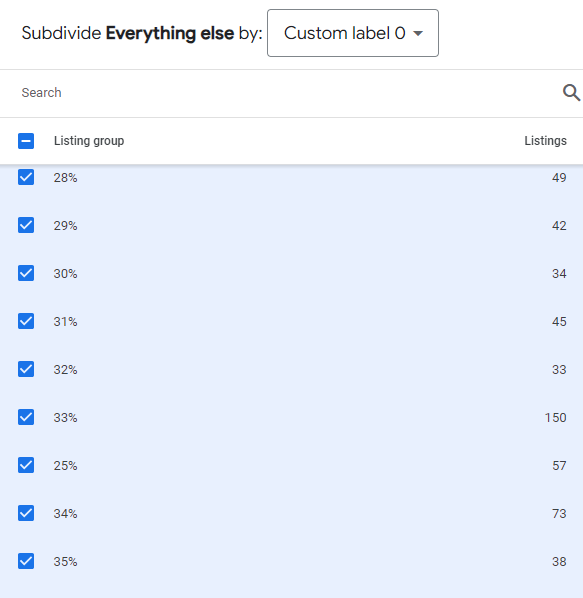
By employing this feature within the feed, you can hone in on focus areas. This will save you time on manual segmentation, as well as giving you additional insights and aligning your marketing strategy with your business goals.
5. Feed Rules

Feed rules are a powerful tool to optimise your product feed quickly, without the need to have access to the raw feed. They give you the ability to manipulate and transform data within the feed, unlocking many new opportunities to enhance your product listings.
There are many different ways that you can use feed rules. The main ones enable you to change required data – if there is some missing or incorrectly formatted – add additional data to incorporate more variables, and also clean up the feed by removing redundant or irrelevant information.
Practical ways to use this could include, for example, temporarily appending “Black Friday Sale” to titles in November. You can also use the “Extract” feature to pull specific data out of titles/descriptions to fill in other attributes e.g. Colour or Size.
Feed rules empower you by enabling you to quickly change attributes in the feed to suit your needs. With the click of a button you can enhance your feed’s relevancy, visibility and the performance of your products to ultimately drive more traffic and conversions to your site.
These are just a few of the ways that you can improve your Google Shopping performance through optimising your product feed, giving your campaigns the best potential within the auctions. By leveraging these tools, you are able to start filling in the gaps and giving Google as much information as possible whilst also giving you more flexibility in your marketing efforts.
Anna Simpson is the Head Of Paid Media at Cedarwood Digital – a performance marketing agency based in Manchester.
PPC
Google Ads Releases New Search Partner Insights & Controls Following Advertiser Concerns

One of Google Ad’s top benefits is its massive reach. Advertisers can easily reach billions of people across the greater web through Google search, Shopping, Maps, Gmail, YouTube, Discover, and more than 2 million different partner websites and apps. Google makes it easy for advertisers to reach all of these constantly updating placements across the web, too. Some of Google’s campaign types–such as Performance Max, App, and Smart campaigns–even automatically target all of these available placements to further simplify reaching this massive audience for advertisers.
However, seasoned advertisers know that not all placements are equally valuable. In fact, your brand’s ad next to the wrong content can upset your customers, damage your brand, and work against your goals. It’s crucial to monitor where your ads appear online to prevent these missteps, but for years, advertisers couldn’t view or control some of their ad placements on Google, specifically in their search partner network.
However, after some recent vocal concerns from brands, Google has responded and released a new tool for some advertisers to review their ad placements across the search partner network and exclude placements that may be inappropriate.
Contents
What is the Google Ads Search Partner network?
Believe it or not, Google isn’t the only search engine across the web! There are hundreds of smaller search engines and millions of websites with search bars–and many of them serve similar PPC ads within their search results. However, most of these smaller sites don’t build their own advertising platforms, such as Google Ads or Microsoft Advertising. Instead, they partner with Google (or Microsoft) to help advertisers connect with searches on their sites. These secondary search engines across the web make up the Search Partner network and collectively make up a decent share of search traffic for many industries.
🚨 Ready to learn how to maximize your campaign success across networks? Start with our free Google Ads Grader!
Google’s Search Network is comprised of two main components:
- Google search sites, which include Google Search, Google Shopping, Google Images, and Google Maps.
- Search Partner network includes YouTube search, smaller partner engines, and sites that host a search bar powered by Google. A surprising number of local and specialty websites are part of the Search Network–including some recognizable tertiary search engines like Ask.com.
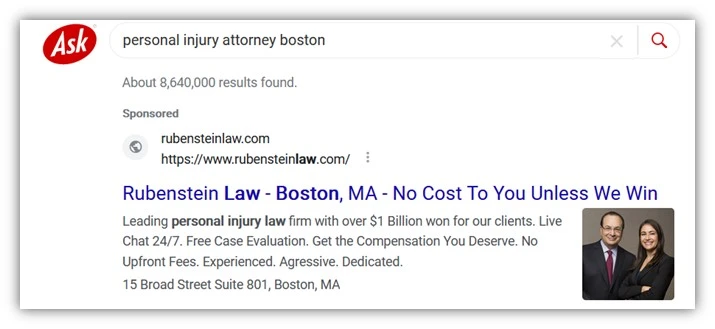
In Google Ads, advertisers can easily view their search campaigns’ results and segment their performance between Google search and the Search Partner network. Within search campaigns, advertisers can easily opt out of the Search Network at any time within their campaigns’ settings.


However, Google’s Performance Max campaigns don’t offer that visibility or flexibility to advertisers. Google’s Performance Max (and other fully automated campaign types) dynamically places your ads across the entire Google network (Google search, search partners, display, YouTube, video, discover, and Gmail) to dynamically use AI to maximize your campaign’s results.
The problems with Google’s Search Partner Network
Google’s Search Partner network’s additional reach is generally positive for advertisers–but that reach comes at additional costs and concerns. Even if most search partners on the network are from reputable, high-quality sites, the vast internet unfortunately hosts many low-quality sites and bad agents.
Google has never previously shared a list or directory of its ever-changing search partners. And unlike placements across the Google Display Network, advertisers haven’t been able to review where their ads appeared on the Search Network. Search advertisers had the choice to buy ads on the entire Search Partner network–or opt out entirely. Advertisers using Performance Max campaigns were automatically included across the entire Google network, including Search Partners.
Over the years, advertisers have become increasingly worried and vocal about the kinds of content their ads appeared alongside, and many advertisers have serious concerns about their brand image across the web.
Recently, Adalytics published a study revealing some concerning placements across the search partner network and discovered that several large companies, agencies, and government agencies were allegedly paying to show ads across some very questionable sites. Some of the examples from their study include pornographic content, pirated content, and sites that may be subject to international sanctions.
Google largely refuted the claims from Adalytics and assured advertisers that ad revenue wasn’t being shared with sanctioned entities. They further asserted that Adalytics claims were exaggerated and that such sites “represent a minuscule amount of [Google’s] Search Partner network.”
Shortly afterward, Google announced it would temporarily allow advertisers to opt out of the Search Partner network in Performance Max and App campaigns until March 1. Advertisers would have to contact Google directly to opt out of Search Partners in these campaigns.
Google’s new Performance Max campaign placement report
Addressing advertiser’s growing concerns, Google announced that it would begin to share more insights into where advertisers’ ads appeared across the web, including on the Search Partner network. Starting on March 4, advertisers can review how frequently their ads appeared across individual placements within their Performance Max and App campaigns.
The report is now available to all advertisers with active Performance Max and App campaigns. However, the reporting is slightly hidden from how advertisers generally review their search queries or other ad placements. Instead, advertisers can find these two new reports within the “report editor” section of the Google Ads dashboard.


The new Performance Max campaign placement report shows where and how often your Performance Max ads appeared on different placements from the web. Unfortunately, the report only shows the ad impressions from your Performance Max campaigns–other performance metrics, such as clicks, costs, and conversions, are unavailable.
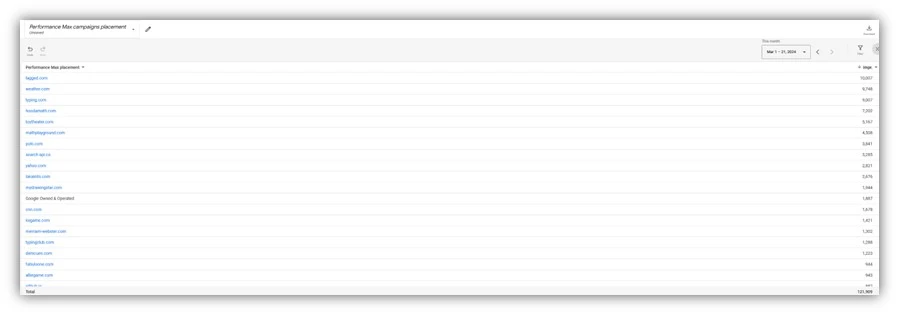

This reporting is only available for Performance Max and App campaigns. Traditional search and shopping campaigns still do not have any reporting available for individual placements across the search partner network.
🛠️ Set your Google Ads campaigns up for success with our free guide to the perfect Google Ads account structure!
How to opt out of Google search partner placements
Starting in March, Google will also allow advertisers to exclude individual Search Partner placements from showing ads for any campaigns in their account, including Performance Max. The placement exclusion can only be added at the account level–unlike many other placement exclusions, which are available at the campaign or ad group level.
To exclude a placement from showing your ads, you will need to create a placement exclusion list and apply it to your account. The Placement exclusion lists are kept under the “Tools and Settings” menu in Google Ads, under the “Shared Library.”
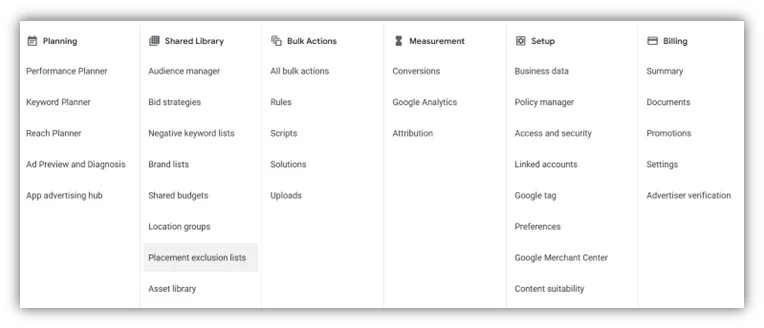

Once you create a new exclusion list, it will automatically be added to all of your campaigns in that account. New placement exclusions may take up to 12 hours to go into effect.
Take control over where your brand shows online
Google’s newest placement reports and exclusion options are designed to give advertisers more visibility into where their ads appear across the web and more control over their brand online. How much you decide to use these controls is up to you, but it’s always a best practice to review your placements and add new exclusions regularly.
Want more like this? How to Use Google’s New Brand Restrictions to Gain Back Control of Your Spend
PPC
5 Campaign Red Flags And Why They Matter

As PPC experts, we rarely have the luxury of harnessing 100% of our efforts and energy into a single account. When we do, it’s usually substantial, with multiple markets, products, and budgets to consider.
With a plethora of metrics to learn and utilize, optimizing our campaigns can feel overwhelming. Over the years, I’ve narrowed the optimization tasks down to focus on five key metrics and red flags. This will allow you to execute fast and effective boosts to campaign performance and efficiencies.
Here are 5 red flags to look out for on your PPC campaigns and, crucially, how to fix them.
1. A Weak Clickthrough Rate
We all know the importance of CTR (click-through rate) as a metric. It serves as a strong indicator of relevance between our keywords, our ads, and the user’s search terms. While the go-to benchmark used to be 2-3%, the introduction of automated bidding strategies and RSAs has moved this closer to 5-6% in most industries.
A CTR below this level raises considerable red flags. Not only does it indicate weak ad group relevancy, but it’s inefficient; the ‘Expected CTR’ of your ad has an effect on your ad rank, and bid, and will see you falling short at auction time.
Here are two simple, yet effective, fixes for a weak CTR:
Take your Assets Reports – a breakdown of the effectiveness of each headline and description – and start by swapping those ranked ‘Poor’ or ‘Average’ to new alternatives on your ads.
The second simple step is to review your ad groups. Over time, your ad groups and your keyword list are both likely to have expanded. Are there any opportunities to separate top-performing keywords from the rest? Do your keywords fit one neat theme, or are multiple themes creeping in? If so, separate them and tailor each ad’s copy to the new themes.
2. Missing or incomplete campaign settings
Back to basics. As someone who has audited 100s of accounts, time and time again I see the same handful of issues. By now, we’re all surely aware of the sneaky default location setting of ‘People interested in your targeted locations’ over ‘People in your targeted locations’. (If not, double-check your campaigns to ensure they’re serving where your target audience is!). There are, however, a few more settings worth checking on, and language settings are one of these.
On Google, language targeting matches queries “where the keywords match and Google believe that the user understands at least one targeted language”. On Microsoft Ads, the language campaign setting “determines the language that you will use when you write your ads and should be the language of your customers”.
Whether or not your brand has a global reach, your ad copy within each campaign is unlikely to be in all languages (often the default setting). When serving an international audience, best practice is to create unique campaigns and ad copy native to the respective local languages. Regional nuance is critical too.
Check your Campaign Settings to ensure that the language of your ad copy matches the audience(s) you’re asking your PPC platform to reach.
3. A lack of exclusions
If you’re running your accounts at peak efficiency, you should have plenty of exclusions in place. With the push towards upgrading your keywords to broad match, performance max black boxes, and a substantial rise in automation techniques, we PPC heroes need to be more on top of exclusions than previously.
Whether you’re running search, performance max, video, or display campaigns, exclusions are likely to apply to your campaigns.
Such exclusions include:
- Negative keywords
- Audience exclusions
- Content suitability, placement, or topic exclusions
- Brand exclusion lists
- Location or country-level exclusions.
If you don’t currently have exclusions applied to your campaigns, that could mean inefficient campaigns: targeting the wrong keywords, showing ads to current customer lists, on irrelevant or harmful content, on competitor content, or even in the wrong country entirely!
As a simple first step, begin by applying negative keywords to your account, campaigns, and/or ad groups and review your basic audience targeting options. If you can exclude current customers, reduce your demographic targeting from 18-65+, and double-check your campaign targeting and exclusion settings, that’s a great start.
4. Sub-par quality scores
One of the easiest ways to create inefficiencies is by failing to monitor quality scores. According to Google Ads, quality score is “a diagnostic tool meant to give you a sense of how well your ad quality compares to other advertisers”. This score is from 1-10, (1 being poor, 10 being excellent), is available at the keyword level, and is a product of the following three factors ranked from “below average” to “average” and “above average”.
- Expected CTR: Based on historical data, how likely is it that your ad will be clicked?
- Ad rank: How closely does your ad match the user’s search query and the intent behind it?
- Landing page experience: How useful is your landing page? Does it answer or support the user’s search query?
Luckily for those of us who struggle with math, the platforms calculate these for us based on the last 90 days of auction insights. In a perfect world, we’d aim for a quality score of 10 – although that may not always be possible. However, 7 or above is indicative of a ‘good’ quality score, with 3 or below being poor.
As with other items mentioned in this list, weak quality scores contribute to inefficient campaigns. To address this, work on optimizing each of the above three factors, starting with any that are ranked “below average”. Remember: the ultimate goal is to ensure that your keywords, ad copy, and landing pages are consistent in content.
5. No conversion data
And finally, one of the biggest red flags is a lack of conversion data. Generating zero conversions is one thing – and may be a red flag, but having no conversion data at all is concerning.
Today, PPC platforms are much stronger – particularly on brand-new accounts – on encouraging conversion setups before creating or publishing a campaign. However, there are plenty of legacy accounts with old, incomplete, or out-of-date conversion tracking, likely leading to millions of dollars in wasted spend annually. If you’ve been putting off the dreaded conversion tracking setup process, don’t delay further.
The final tip here is to ensure your conversion tracking is up to today’s standards. While conversion tracking for the end-goal of your campaigns is undeniably important, you’ll also want to track ‘lighter’ conversion events to give your PPC platform all the signals it needs to generate conversions – particularly when using smart bidding strategies.
If you’re using Maximize Conversions, Target CPA, Target ROAS, or Maximize Conversion Value smart bidding strategies and you have multiple conversion methods tracked (such as app downloads, phone calls, lead form fills, and product page views), ensure that each conversion is set up as a ‘Primary’ or ‘Secondary’ conversion goal respective to how important it is. Multiple primary conversion goals will make it difficult to optimize your campaigns.
Summary
Whether you’re brand new to PPC or have decades of experience, frequent platform changes often mean adapting what you thought you already knew! The five tips above should give you a great starting point for optimizing, improving, and boosting the efficiency and effectiveness of your accounts. Good luck!
-

 MARKETING6 days ago
MARKETING6 days ago18 Events and Conferences for Black Entrepreneurs in 2024
-

 MARKETING7 days ago
MARKETING7 days agoIAB Podcast Upfront highlights rebounding audiences and increased innovation
-

 PPC6 days ago
PPC6 days agoGoogle Ads Benchmarks 2024: New Trends & Insights for Key Industries
-

 SEO6 days ago
SEO6 days agoWhy Google Can’t Tell You About Every Ranking Drop
-

 SEO7 days ago
SEO7 days agoHow To Use ChatGPT For Keyword Research
-

 PPC7 days ago
PPC7 days agoThe Ultimate Guide to Click Fraud
-

 PPC5 days ago
PPC5 days ago86 Summer-Ready June Content Ideas
-

 SEO6 days ago
SEO6 days ago56 Google Search Statistics to Bookmark for 2024








